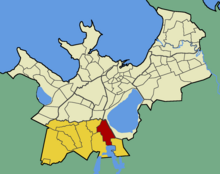Liiva

Liiva (in German " Sand ") is a district ( Estonian asum ) of the Estonian capital Tallinn . It is located in the Nõmme district .
description
The city district has 1,289 inhabitants (as of May 1, 2010). Its area is 3.25 square kilometers.
Liiva used to be called Liiva-Risti and was only sparsely populated. Until the 19th century, a large pine forest stretched between the historic taverns of Liiva and Vana-Risti. Both jugs are already listed on Ludwig August Mellin's map from 1798.
The construction of a railway connection between Tallinn and Paldiski (1869/70) brought Liiva out of her slumber. In 1900 the narrow-gauge railway was added between Tallinn and Viljandi . Shortly before the outbreak of the First World War , the Liiva train station was opened. In 1927 the wooden station building was replaced by a modern building. Liiva station is now served by the Estonian railway company Edelaraudtee .
With the railway, industrial companies also settled in Liiva. The first attempts to establish a building materials industry for silicate stone were made in 1899. But it wasn't until 1910 that the company of the entrepreneur Oskar Amberg (1878–1963) had more lasting success. It shaped Liiva's cityscape until the Soviet occupation of Estonia. From 1923 the successful Estonian company Liiva-Betoon , which manufactured components, was added.
Liiva cemetery
In September 1935, the Liiva ( Liiva kalmistu ) cemetery was officially inaugurated. In the same year the chapel was built (architect Herbert Johanson ). The Estonian politician Hans Martinson (1871-1935) was buried in Liiva on January 28, 1935 .
Liiva Cemetery was Tallinn's largest cemetery until 1978, with an area of 64 hectares. At first it blended harmoniously into a wooded landscape. Over time the tree population was decimated more and more.
Since April 1940, the cemetery has had a separate area for the deceased inmates of the Seewald mental hospital . This is where the Estonian poet Marie Heiberg (1890–1942) found her final resting place. Her tomb from 1965 was made by the Estonian sculptor Juhan Raudsepp . Many of those buried were buried without a name.
During the German occupation of Estonia (1941–1944), the German troops used a wall and a ditch in the cemetery area as a place of execution. Here, among others, the educator Aleksei Jaanson (1866-1941) and the politician Neeme Ruus (1911-1942) were shot by the Germans.
Numerous Estonians who fell victim to the German occupation of the country (1941–1944) are buried in the cemetery. These include the actor Harri Paris (1891–1941), who, together with his Jewish wife Keila (1891–1941), committed suicide before being transported to the National Socialist extermination camps.
In Liiva there is a communal grave for 164 Soviet prisoners of war who perished between 1941 and 1944. A memorial erected in 1975 commemorates their fate.
Lake Raku ( Raku järv ) begins south of the cemetery .
literature
- Karl Laane: Tallinna kalmistud ["The Tallinn Cemeteries"]. Tallinn 2002, pp. 207–221 ( ISBN 9985-64-168-X )
Web links
- Story of Liiva (Estonian)
- Liiva Cemetery (Estonian)
Individual evidence
- ↑ Archived copy ( Memento of the original from May 17, 2011 in the Internet Archive ) Info: The archive link was inserted automatically and has not yet been checked. Please check the original and archive link according to the instructions and then remove this notice.
Coordinates: 59 ° 23 ' N , 24 ° 43' E
